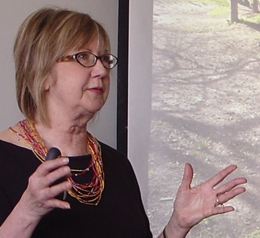 Humans have an intimate and intangible relationship with the natural and built environments we have constructed.“Buildings are not just something that provide a roof over our heads,” said Dr. Judith Heerwagon at a workshop held recently at Central Oregon Community College.The workshop introduced a bright new framework for sustainable design.Strong evidence from academic case studies supported Heerwagon’s concept of design that progresses far beyond the minimum requirements for Green Building, and instead advocates a much broader, more holistic approach.
Humans have an intimate and intangible relationship with the natural and built environments we have constructed.“Buildings are not just something that provide a roof over our heads,” said Dr. Judith Heerwagon at a workshop held recently at Central Oregon Community College.The workshop introduced a bright new framework for sustainable design.Strong evidence from academic case studies supported Heerwagon’s concept of design that progresses far beyond the minimum requirements for Green Building, and instead advocates a much broader, more holistic approach.
Heerwagon discussed the basic needs of human beings including fascinating examples of design that correspond to those basic needs, biophilic design, and a model for sustainable design called the Do-Good model.
Dr. Heerwagon offered quantitative as well as qualitative data to support the new model of sustainable design, translated into laymen’s terms.As each case study was presented, the workshop participants were asked to respond and generate solutions to design problems that satisfy the Do-Good model.The workshop featured an informative dialogue among riveted peers about the past, present and future of design and the emerging paradigm of green design.
One of the most convincing cases was a reference to the paradigm shift in zoo design, specifically primate environments.The isolated concrete containers that have housed captive primates encourage dysfunctional, aggressive behavior and a decline in reproductive fertility.Zoo designers were beside themselves.Through studies of the typical behaviors of wild primates, they determined that a living environment that supported curiosity, exploration and foraging produced healthier primates, which in turn generated more offspring, longer life-spans in captivity and more satisfied zoo visitors.Designers enhanced the environment with plant and animals species that occur in the natural habitat of primates.
This is a simple lesson, but one that has a profound impact on the future of design.A designer of a built environment must know the needs of the animal for which it is designed.They must study and have acute awareness for the preferences and patterns of behavior that exist naturally.
Heerwagon introduced the basic needs theory, which holds that food, water, shelter and psychosocial well-being are paramount to the vitality of a human individual.The latter includes concepts such as a sense of belonging, social engagement, rest and restoration, self expression, control, choice, connection to nature, sensory variability.This was the premise of the entire workshop.
The Do-Good model is in contrast to the do-no-harm model.The Do-No-Harm model complies with regulations and the minimum requirements for rating systems such as LEED.LEED, (Leadership in Energy and Environmental Design) is a Green Building Rating System that is a nationally accepted benchmark for the design, construction, and operation of high performance green buildings (US Green Building Council).As Green building has become a trend and a profitable marketing tool, simply decreasing energy use in buildings can be beneficial but also flawed.
The Do-Good approach emphasizes the need for more stringent, self-imposed design standards with a genuine intention in the design and construction process.The Do-Good concept considers human physical, social, cognitive and emotional needs in design.
One of the workshop facilitators and local architect Mary Louise Vidas commented that “is it significant to see not only creatives and builders, but representatives from the school district present.”In addition, this design model encourages beauty, spirituality and inspiration, “supporting human beings at all levels,” says Vidas.
This new paradigm of sustainable or green design must be holistic and interdisciplinary.Len Meserve, one of the impassioned workshop participants, commented that the event “addresses something that has been missing from the local discussion of sustainable design.”
Design affects the entire community.Bend is a progressive and quickly growing community with a massive capacity for sustainable design.Green design is not merely a trend.The new paradigm is upon us.
Information: Sustainable Building Advisor Course, 541/383-7270 or ceinfo@cocc.edu.
To comment on the article, please contact Romana Cohen at 541/388-5665 or at intern@cascadebusnews.com.

